A look at Windows 8 Tablets running on TI, Qualcomm, Nvidia, AMD and Intel silicon
by Brian Klug on September 14, 2011 9:00 PM ESTThis afternoon (and yesterday) we had a chance to meet with a number of SoC vendors who have partnered with Microsoft for Windows 8. Each of them has their own individual reference tablet running Windows 8, and today we had a chance to survey the landscape and get photos of all the tablets. We started with ARM, then looked at x86 based tablets. Of course, the real goal with Windows 8 is to abstract as much of the difference between these two platforms away.
Unfortunately, all of the ARM vendors were required to keep their tablets under glass and out of the way of physical contact per Microsoft instruction. Microsoft isn't ready to show off the ARM version of Windows 8 for a variety of reasons at this point (at least without a Microsoft rep. present), but we still got a chance to at least take a look at what there is now. Microsoft is encouraging tablet makers to target either a 10.1" or 11.6" form factor with 1366x768 resolution (ed: Metro will require 1024x768 as a minimum, so 1280x720 displays don't meet Microsoft's requirements).
Texas Instruments
First up is TI, whose development platform was demoed playing back the 1080p30 H.264 baseline video shown in the keynote fluidly in windows media player with a split-screen view. One tablet displayed the start menu, another displayed two split screen games. TI's development platform as shown right now is running on OMAP 4430, which again consists of two ARM Cortex A9s at 1.0 GHz and PowerVR SGX 540 graphics. Windows 8 won't launch on OMAP 4430, however, instead it'll launch on the more powerful OMAP 4470 platform with PowerVR SGX544 graphics and a 2D display compositor. The reason is partly due to SGX544 having full Direct3D 9.3 compliance, partly because it's an all around faster platform. I'm told that right now there's some Direct3D emulation going on as well for all the SoCs that don't support Direct3D 9.3.
I also recorded a short video showing the TI Windows 8 tablet in action.
Qualcomm
My next stop was Qualcomm, whose current development tablet runs on an MSM8660 SoC, which consists of two scorpion cores and Adreno 220 graphics. Qualcomm took the tablet out of the glass box for us and showed a quick demonstration of the start menu scrolling back and forth, and the IE10 mobile view working and scrolling around.
Unfortunately we weren't allowed to shoot video of the tablet while that demo was running, but we did grab some photos of the tablet without the glass box. Performance on the start menu looked to be above 30fps the whole time but not buttery smooth like the x86 tablets we've seen so far.
Just like TI, Qualcomm won't go to market with the SoC they're demonstrating Windows 8 working on today, instead they'll use the more powerful dual core Krait MSM8960 at first and quad core Krait APQ8064 later on. Dual core krait SoCs (eg 8960, 8270, 8260A) come with Adreno 225, quad core krait (APQ8064 and others) come with Adreno 320, both of which are Direct3D 9.3.
NVIDIA
We've seen NVIDIA's Kal-El quad-core A9 based tablet a few times now, and found it out on the floor, also behind glass. Unlike the other vendors, NVIDIA hasn't said anything about going to market for Windows 8 with anything but Kal-El, and I don't see any reason why they should either.
The Kal-El development tablet was seated in a nice looking dock with what looks like one USB 3.0 port and a full size HDMI port.
AMD
Switching over to the x86 camp, we have AMD, who showed us two tablets running on Brazos - the Acer Iconia Tab W500 and MSI WindPad 110W, which use a C-50 and Z-01 APU, respectively. Displays on these are 1280x800 and support capacitive touch just like you'd expect for Windows 8.
Both the MSI WindPad and Iconia Tab felt snappy and responsive running the same Windows 8 Developer Preview build that we've used on the Samsung developer hardware. Subjectively, the WindPad's capacitive panel was more responsive and less prone to errant touch recognition than the Iconia, though both were more than useable with Windows 8.
Intel
Last but not least is Intel's own development tablet, which is running an unnamed 32nm SoC. Intel was suspiciously silent about which particular SoC was inside this device, and you'll notice that it too is locked down in a plastic box, lumping it squarely in the next-gen SoC category for Microsoft.
It's possible this is Medfield, it's also possible this is some 2nd gen 32nm Atom SoC. Hopefully we'll find out more as Windows 8 starts getting closer to launch.


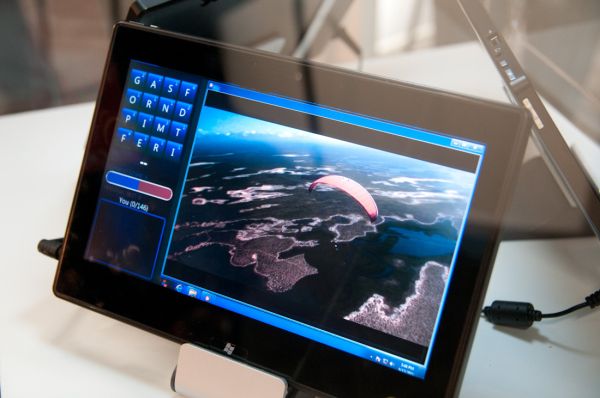
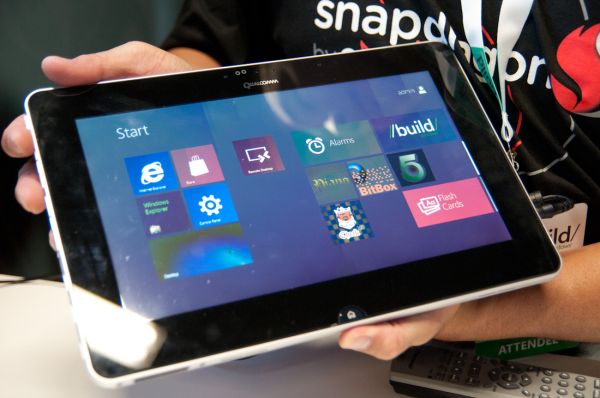
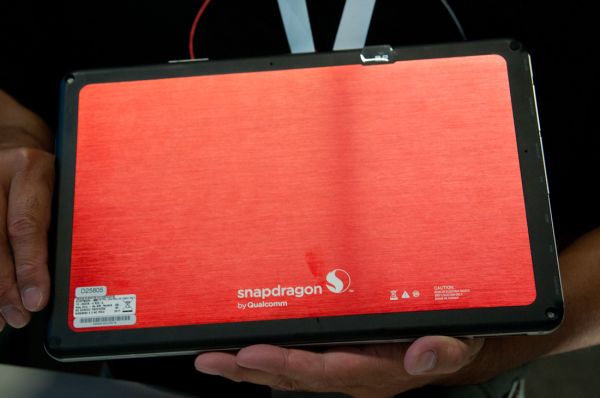
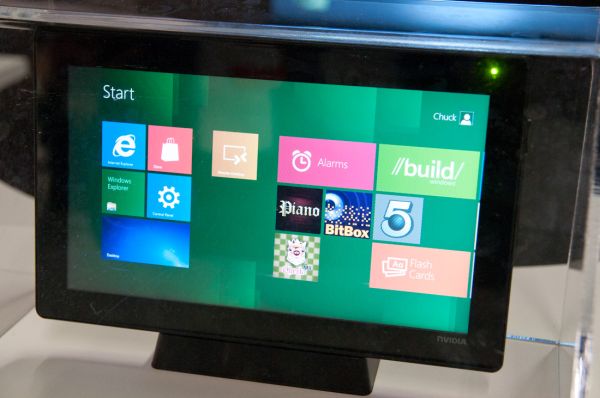
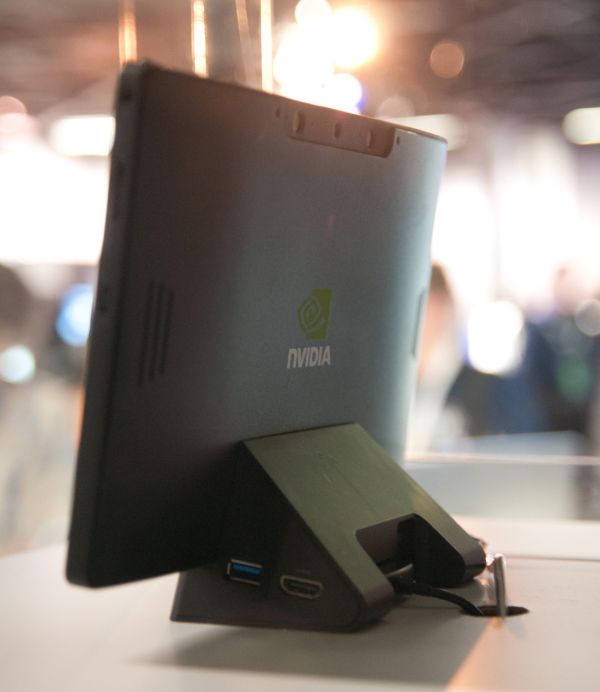
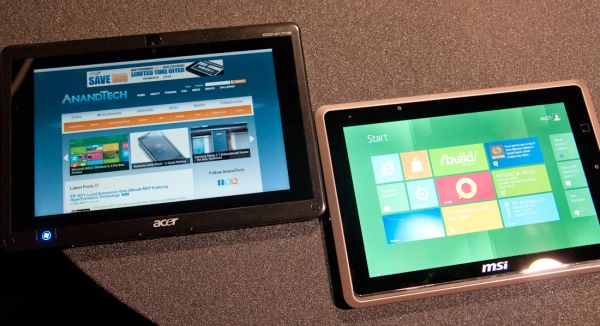
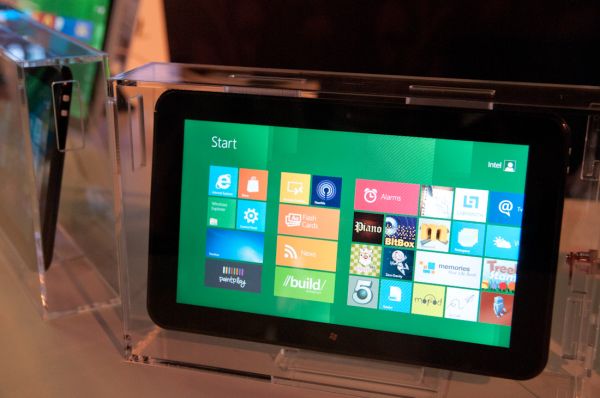














92 Comments
View All Comments
HMTK - Thursday, September 15, 2011 - link
Lots of shortsighted people here. Microsoft is primarily interested in selling to businesses. That's why past Windows tablets "failed" and why Windows Mobile was "not as good" as other smartphone platforms. Windows 8 on something else than x86 makes a lot of sense. It'll be manageable using standard tools like Group Policy. If you can't run x86 software on it you will probably be able to connect to a Remote Desktop Server, Citrix Xenapp or some VDI solution which WILL be able to run said software even on an underpowered tablet.I just don't like the widescreen format. There Apple has chosen wisely with a 4:3 format.
silverblue - Thursday, September 15, 2011 - link
Perhaps, and they'll sue you if you try to use it. ;)HMTK - Thursday, September 15, 2011 - link
Damn. How could I forget that!roybob - Thursday, September 15, 2011 - link
I, too, always thought Microsoft was interested in selling to businesses. That changed when Windows Mobile 7 came out. The ability to directly sync a phone to Outlook contacts and calendars on my computer has ended. I don't want all my business contacts on the Hotmail cloud, so now my phone choices are Apple or Blackberry. So much for supporting businesses, at least on the mobile platform.HMTK - Thursday, September 15, 2011 - link
Yeah, I really, REALLY hate that as well. I've asked our Microsoft rep in Belgium about this and she said more people have complained, even business users. I hope this gets fixed in Mango but I'm not holding my breath.Cloud sometimes sucks.
Dug - Friday, September 16, 2011 - link
It's reported that Mango does change that. There were numerous complaints.steven75 - Thursday, September 15, 2011 - link
Or you can just do that right now (as we are seeing happen in the market) with an iPad and the iPad Configuration Utility as well as with third-party apps.Remote Desktop and Citrix on on the iPad TODAY.
fteoath64 - Sunday, September 18, 2011 - link
@HMTK: The thin-client model failed in the past due to scalable issues on the server-side. Business does not use it in a big way and neither did large enterprises. RDT is useful in support scenario only and some sysadmin work and not much else. We see that the "lite-client" using the webserver and Internet scales very well and cheap to develop on. But does have security challenges. Tablets are your ideal lite-client terminals.damianrobertjones - Thursday, September 15, 2011 - link
Why oh why can't anyone simply say that it's the Samsung 7 Slate is beyond me?B3an - Thursday, September 15, 2011 - link
EVERYONE should just watch the Microsoft Build video keynote from yesterday. Theres so many ignorant comments here from people that know absolutely nothing.http://channel9.msdn.com/events/BUILD/BUILD2011/KE...
Many Win 8 things will be explained if you just watch it.